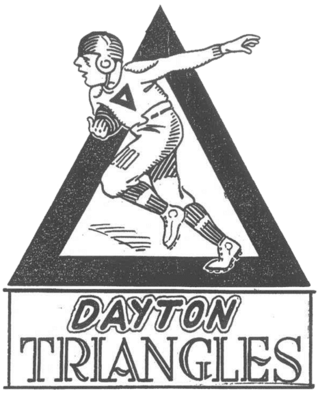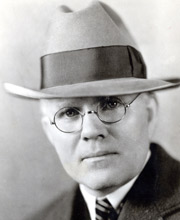Related Research Articles
The Columbus Panhandles were a professional American football team based in Columbus, Ohio. The club was founded in 1901 by workers at the Panhandle shops of the Pennsylvania Railroad. They were a part of the Ohio League from 1904 before folding after one season. Three years later, the team tried again, playing in the Ohio League from 1907 to 1919, not winning a championship, before becoming charter members of the American Professional Football Association (APFA) which became the National Football League (NFL).

The Dayton Triangles were an original franchise of the American Professional Football Association in 1920. The Triangles were based in Dayton, Ohio, and took their nickname from their home field, Triangle Park, which was located at the confluence of the Great Miami and Stillwater Rivers in north Dayton. They were the longest-lasting traveling team in the NFL (1920–1929), and the last such "road team" until the Dallas Texans in 1952, who, coincidentally, descended from the Dayton franchise.

The Rock Island Independents were a professional American football team, based in Rock Island, Illinois, from 1907 to 1926. The Independents were a founding National Football League franchise. They hosted what has been retrospectively designated the first National Football League game on September 26, 1920 at Douglas Park. The Independents were founded in 1907 by Demetrius Clements as an independent football club. Hence, the team was named the "Independents."

Joseph Francis Carr was an American sports executive in football, baseball, and basketball. He is best known as the president of the National Football League from 1921 until 1939. He was also one of the founders and president of the American Basketball League (ABL) from 1925 to 1927. He was also the promotional director for Minor League Baseball's governing body from 1933 to 1939, leading an expansion of the minor leagues from 12 to 40 leagues operating in 279 cities with 4,200 players and attendance totaling 15,500,000.
The 1920 APFA season was the inaugural season of the American Professional Football Association, renamed the National Football League in 1922. An agreement to form a league was made by four independent teams from Ohio on August 20, 1920, at Ralph Hay's office in Canton, Ohio, with plans to invite owners of more teams for a second meeting on September 17, 1920. The "American Professional Football Conference" (APFC) was made up of Hay's Canton Bulldogs, Akron Pros, the Cleveland Tigers and the Dayton Triangles, who decided on a six-game schedule to play each other at home-and-away, an agreement to respect each other's player contracts, and to take a stand against signing college students whose class had not yet graduated.

The 1920 Akron Pros season was the franchise's inaugural season with the American Professional Football Association (APFA) and twelfth total season as a team. The Pros entered the season coming off a 5–5 record in 1919 as the Akron Indians in the Ohio League. The Indians were sold to Art Ranney and Frank Nied, two businessmen, to help achieve a better record and crowd. Several representatives from the Ohio League wanted to form a new professional league; thus, the APFA was created.
A nameless professional American football team, based in Syracuse, New York and generically known as the Syracuse Pros or Syracuse Eleven, was once thought to have joined the American Professional Football Association (now the National Football League for the 1921 season. The team was coached by Mike Purdy and managed by Andy Friedman. Syracuse University multi-sport standout John Barsha was the team's franchise player.
The 1920 Buffalo All-Americans season was the franchise's inaugural season with the American Professional Football Association (APFA), an American football league, and fifth total as a team. The All-Americans entered 1920 coming off a 9–1–1 record in 1919 as the Buffalo Prospects in the New York Pro Football League (NYPFL). Several representatives from another professional football league, the Ohio League, wanted to form a new national league, and thus the APFA was created.

The 1920 Canton Bulldogs season was the franchise's sixteenth and its first in the American Professional Football Association (APFA), which became the National Football League two years later. Jim Thorpe, the APFA's president, was Canton's coach and a back who played on the team. The Bulldogs entered the season coming off a 9–0–1 performance as Ohio League champions in 1919. The team opened the season with a 48–0 victory over the Pitcairn Quakers, and finished with a 7–4–2 record, taking eighth place in the 14-team APFA. A then-record crowd of 17,000 fans watched Canton's week 12 game against Union AA of Phoenixville.
The 1920 Cleveland Tigers season was the franchise's inaugural season in the American Professional Football Association (APFA) and fifth total as an American football team. The Tigers entered the season coming off a 5-win, 2-loss, 2-tie (5–2–2) record in 1919. After the 1919 season, several representatives from the Ohio League, a loose organization of professional football teams, wanted to form a new professional league; thus, the APFA was created.
The 1920 Columbus Panhandles season was the franchise's inaugural season in the American Professional Football Association (APFA)—later named the National Football League. The season concluded with the team going 2–6–2 and finishing 13th place in the APFA standings. The Panhandles entered the season after a 3–6–1 record in 1919. The team opened the 1920 season with a loss to the Dayton Triangles, and the Panhandles lost five straight until a victory over the Zanesville Mark Grays. Not a single player was on the All-Pro list.
The 1920 Dayton Triangles season was the franchise's inaugural season in the American Professional Football Association (AFPA)—later named the National Football League. The Triangles entered the season coming off a 5–2–1 record in 1919 in the Ohio League. After the 1919 season, several representatives from the Ohio League wanted to form a new professional league; thus, the APFA was created. A majority of the team stayed from the 1919 team, including the coaching staff, while two players left the team.
The 1920 Hammond Pros season was the franchise's inaugural season in the American Professional Football Association (APFA) and second as an American football team. The Pros entered 1920 coming off a 4-win, 2-loss, 3-tie (4–2–3) record in 1919 as an independent team. Several representatives from another professional football league, the Ohio League, wanted to form a new national league, and thus the APFA was created.
The 1920 Muncie Flyers season was the franchise's inaugural season in the American Professional Football League (APFA)—later named the National Football League. The Flyers entered the season coming off a 4–1–1 record in 1919. Several representatives from the Ohio League wanted to form a new professional league; thus, the APFA was created. The 1920 team only played in one game that counted in the standings: a 45–0 loss against the Rock Island Independents. This game and the Columbus Panhandles–Dayton Triangles on the same date is considered to be the first league game featuring two APFA teams. The Flyers tried to schedule other games, but the opponents canceled to play better teams. As a result, the Flyers had to play the rest of the season's game versus local teams. In week 10, the Flyers won a game against the Muncie Offers More AC for the Muncie City Championship. No players from the 1920 Muncie Flyers were listed on the 1920 All-Pro Team, and no player has been enshrined in the Pro Football Hall of Fame.
The 1920 Rock Island Independents season was the American football franchise's thirteenth season and inaugural season in the American Professional Football Association (APFA). The Independents hosted first ever APFA/National Football League contest on September 26, 1920. After the AFPA had been formed on September 17, 1920, Douglas Park was the venue as the Independents hosted the St. Paul Ideals, winning 48-0 in the new league's first contest.
Severin Joseph Checkaye was a professional football player, coach and owner. He was also a co-founder of the National Football League (NFL). Checkaye's franchise, the Muncie Flyers was a charter member of the league.
The Zanesville Mark Grays were an Ohio League and Independent football team that existed for seven seasons. They played in 4 Ohio League seasons.
The Gary Elks were an Independent American football team that played four seasons. From 1920 to 1923.
The Chicago Boosters were an Independent American football team that played two seasons from 1920 to 1921. They played in one APFA game.
John Lee "Bullet" Snoots was an American football back who played nine seasons professionally. He played with the Columbus Panhandles for eight seasons and the West Side A.C. for one season.
References
- 1 2 3 4 5 "1920 Columbus Wagner Pirates - Pro Football Archives". www.profootballarchives.com.
- 1 2 3 4 5 "1921 Columbus Wagner Pirates - Pro Football Archives". www.profootballarchives.com.
- 1 2 3 4 5 "1922 Columbus Wagner Pirates - Pro Football Archives". www.profootballarchives.com.
- 1 2 "1923 Columbus Wagner Pirates - Pro Football Archives". www.profootballarchives.com.
- ↑ "1924 Columbus Wagner Pirates - Pro Football Archives". www.profootballarchives.com.
- ↑ "1925 Columbus Wagner Pirates - Pro Football Archives". www.profootballarchives.com.
- 1 2 "1926 Columbus Wagner Pirates - Pro Football Archives". www.profootballarchives.com.